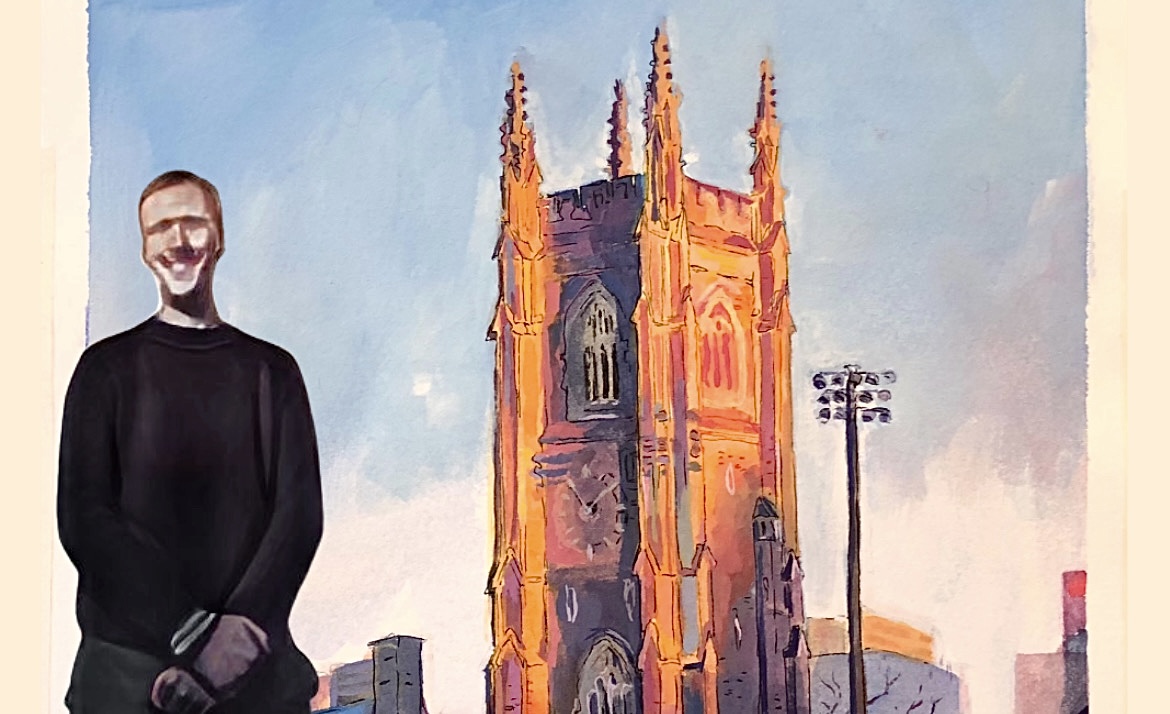The Soldiers’ Tower: U of T’s castle
Taking us on a tour of the Soldiers’ Tower, Daniel Hendrickson, chair of the Soldiers’ Tower Committee, emphasizes the building’s role as a house of remembrance.
When describing the architecture of the University of Toronto Mississauga (UTM), one may use words such as contemporary and sleek. While our campus may have more modern comforts than the downtown campus, hidden gems lie beyond the gothic architecture of the St. George campus in the middle of Toronto.
One of U of T’s jewels includes the Soldiers’ Tower. With the guidance of Daniel Hendrickson, U of T alumni and chair of the Soldiers’ Tower Committee, The Medium takes an in-depth look at the Soldiers’ Tower, a castle-like building on the downtown campus. Hendrickson, who became involved with the Soldiers’ Tower after stumbling into its Memorial Room on a whim, feels passionately about bringing attention to the tower, especially as it will celebrate its centennial in the coming year.
The Soldiers’ Tower stands 43.6 metres tall and serves as a link between University College and the Hart House. Though the tower may go unnoticed by busy students, Hendrickson sheds some light onto the tower’s majesty, history, and significance to U of T as a whole.
Pointing at artifacts that cover the inner wall of the tower, Hendrickson explains, “The tower, unveiled in 1924, was built with the intention of honouring the 628 U of T staff, students, and alumni who had fallen during Canada’s efforts in the First World War.” Hendrickson shares that the university continued to play a crucial role in Canada’s war efforts, including training members of the U of T community to be fully prepared and capable soldiers of the Canadian Armed Forces. The university’s members would carry on their effort throughout the Second World War, during which another 557 members of the U of T community died.
While the whole tower pays homage to our fellow Canadians, the Memorial Room, which sits at the top of the stained glass decorated Staircase of Honour, showcases historic artifacts and memorabilia significant to the history of U of T as well as Canadian history. Anyone who’s visited the Memorial Room may have thought that the tower ended there, but with the president of the committee as my tour guide, I was granted a sneak peek into the treasures that lie above the Memorial Room.
Tucked away between the tower’s archway and façade lies a tiny wooden door bearing gold lettering “Carillon.” Having no musical knowledge, I had no idea what I would encounter on the other side of the ancient-looking door. Upon first opening the door, a visitor is greeted by a very narrow and seemingly never-ending spiral staircase. “Are any of you claustrophobic? Well, it’s too late to turn back now,” jokes Hendrickson. “This staircase may be the only one of its kind in Ontario,” he remarks, leading us up the stairs which certainly don’t meet the standards of today’s building codes.
After the spiralling staircase finally reaches its first landing, visitors are greeted by a very tall, medieval-looking room, much like those seen in castles scattered throughout Europe. The main feature of the room is the practice carillon—which looks like sideways xylophone, played with pedals and keys—where a select few students practice playing the instrument without disturbing anyone on campus. With light being funnelled through arrow-slit windows, one is sent back in time. Feelings of the past are amplified through the display of old U of T flags, ancient technology, and a clock moved by a pulley system so unique that, as Hendrickson notes, “only one technician in all of Ontario knows how to repair it.”
Continuing back up the stairs, we reach the location from which the actual carillon is played. Warning to tall visitors—several low, incredibly hard steel beams will meet your head, should you forget to duck while crossing the bridge between the stairs and the instrument.
The last and most awe-inspiring part of the tour is the bell tower. After a few more steps and opening a hatch akin to one on a battleship, one is greeted by the full majesty of the carillon. The top floor of the tower is a very tall and airy space which contains 52 brass bells, connected by a series of steel strings to the instrument below. To convey the scale of the carillon, the largest bells, responsible for making the deepest sound, can house a six-foot-two person inside of them. When asked about how the carillon was placed within the tower, Hendrickson shared that the bells had to be “dropped into the tower from a hole in the ceiling during construction.”
The carillon extends up into the high heavens with the topmost tier housing the smallest bells. Hendrickson notes that the bell room is a place of spectacle, especially as it houses the “second tallest carillon in the province, coming second only to the Peace Tower in Ottawa.” Though the bell room is a space of awe, the bells serve a much deeper purpose–they serve as a somber reminder of our fallen colleagues. Knowing the history and significance of the 52 bells makes the solemn songs emanating from the tower even more meaningful.
On the way down, one must again face the never-ending, nausea-inducing staircase, all the way back out the tiny door, where one will be greeted by the adjacent archway. The Soldiers’ Tower, much like the TARDIS, a fictional time machine featured on Doctor Who (2005), takes a visitor through time and space and certainly appears to be bigger on the inside. Serving as a house of remembrance as well as a melodic chamber, the tower is a gem that should be precious to all members of the U of T, especially as it gives students a moment to reflect on the past, present, and future of one’s life at U of T. So, next time you find yourself on the shuttle from UTM to St. George, whether it be for a class or to visit Robarts, be sure to admire the tower, as there is more to it than meets the eye.
Design Editor (Volume 50); Associate Photos Editor (September-December, Volume 50) — Beatriz is a third-year Art & Art History specialist. When she’s not in class taking notes on Fragonard or Davinci, you can find her checking out the newest exhibits at the AGO. Non art-related hobbies include thrifting, creating various boards on Pinterest, and watching Star Trek with Sherlock, her black Maine Coon, by her side.


